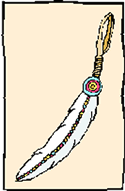
Home | Literature | Environment | Regions | Contacts and Links | About Us

Home | Literature | Environment | Regions | Contacts
and Links | About Us
Dorothy Fry Arbuckle
 Grade
Level:
Grade
Level:
6-8
Subjects:
Science: Environment
Social Studies: History
English: Literature
Overview:
Dorothy Fry Arbuckle wrote two novels regarding early life in Indiana, The After Harvest Festival and Andy’s Dan’l Boone Rifle. These novels discuss what it was like to be a pioneer, including the relationship between Native Americans and pioneers. They also discuss the abundance of wildlife that lived in the area, and how the population of animals lessened because of trapping.
Purpose:
The purpose of this lesson plan is to make a connection between Indiana’s environment and literature, and to give students a view on early life in northwest Indiana.
Objectives:
1) To explore natural disasters, including forest fires, floods,
and tornadoes.
2) To explore the wildlife that is now extinct or extirpated from
Indiana.
3) To explore the relationship between pioneers and Indians.
4) To explore the habitat known as the “Great Marsh.”
Procedures:
This is intended to be a five-day lesson plan that helps students connect Indiana’s environment and literature.
Day 1
Social Studies:
First, determine the students’ pre-existing knowledge of the pioneers. Ask the students to share what comes to mind when they hear the word “pioneer,” and keep track of their answers.
After getting responses from the students, begin the lesson on pioneers and early settlers in Indiana.
Discuss with the students:
1) The various reasons that people began to move west.
2) Factors that led some pioneers to settle in the Indiana territory,
such as the river systems located there.
3) The pioneers’ attitudes toward the wilderness.
4) The relationship between the pioneers and the Native Americans.
English:
Read aloud the first two chapters of The After Harvest Festival. After today, the students will be responsible for reading the remainder of the novel for homework. Nightly assignments will be different for every class, depending on the grade level.
Day 2
Social Studies:
Discuss the various aspects of daily life of the Native American tribes that used to live in northwest Indiana and that are discussed in the book.
1) Miami tribe
2) Pottawatomie tribe
Science:
Determine the students’ pre-existing knowledge of natural disasters. This will help you decide how extensive the lesson should be.
Discuss how each of the following natural disasters occurs, and its effect on wildlife and their habitat:
1) Forest fires
2) Floods
3) Tornadoes
English:
Creative writing: Have the students write a short essay detailing their thoughts of what was read in class the previous day, including the daily life of pioneer children vs. a typical day in their own lives.
Day 3
Science:
Discuss with the students the various environmental habitats of the Great Marsh, including the Kankakee River, the wetlands, and the prairies.
English:
Library time: Split the class into groups and give the students time in the library to research the Native American tribes that lived in Northwest Indiana. This will lead to activities on days four and five of the lesson plan.
Day 4
Social Studies:
Activity #1: Based on the research done on day three, students will use Popsicle sticks to make a Native American dwelling.
Science:
Discuss the species mentioned in the book that are now extinct,
endangered, or extirpated from Indiana.
1) Passenger pigeons
2) Whooping cranes
3) Panthers
4) American Bison (“buffalo”)
5) Bobcats
English:
Library time: Take the students to the library to finish their research for the activity done on day five.
Day 5
Social Studies:
In their groups, students will give a short oral report on what they think may be a typical day in the life of Native Americans, based on their research.
English:
After a short review, have the students write a poem on one of
the extinct, endangered, or extirpated species of Indiana.
|
||||||||||||||||||